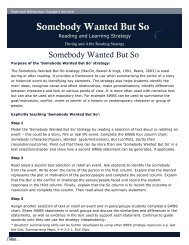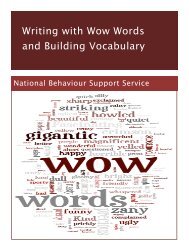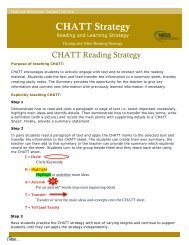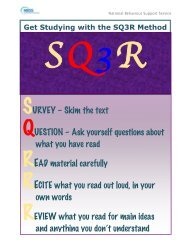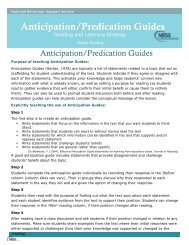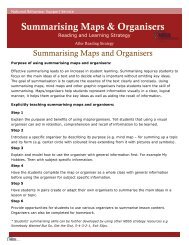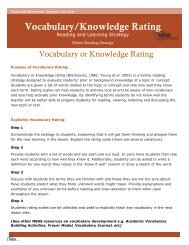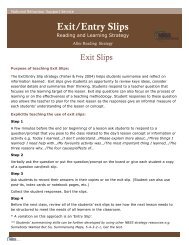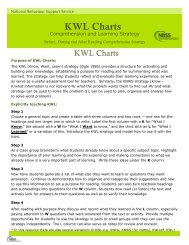View/Download PDF - NBSS
View/Download PDF - NBSS
View/Download PDF - NBSS
- No tags were found...
Create successful ePaper yourself
Turn your PDF publications into a flip-book with our unique Google optimized e-Paper software.
Speech, Language andCommunication Needs inAdolescenceNational Behaviour Support Service
National Behaviour Support Service (<strong>NBSS</strong>)Navan Education CentreAthlumneyNavanCo. MeathTelephone: +353 46 9093355Fax: +353 46 9093354Email: nbss@ecnavan.ieWeb: www.nbss.ieThe National Behaviour Support Service (<strong>NBSS</strong>) was established by theDepartment of Education & Skills in 2006 in response to therecommendation in School Matters: The Report of the Task Force onStudent Behaviour in Second Level Schools (2006).The <strong>NBSS</strong> is funded by the Department of Education and Skills under theNational Development Plan 2007 – 2013This information leaflet for teachers and schools was written by AoifeMurphy, Senior Speech and Language Therapist <strong>NBSS</strong>, in conjunction withDepartment of Speech and Language Therapy, University of Limerick.© 2011 National Behaviour Support ServiceInformation Leaflet for Teachers and Schools 2
Contents Introduction Page 4 What is Speech and Language Therapy? Page 5 What is the Role of the Speech and Language Therapist in Schools? Page 5 What are Speech and Language and Communication Needs? Page 6 Identifying Speech and Language and Communication Needs in the Classroom Page 13 References Page 15 Information Leaflet for Teachers and Schools 3
What is Speech and Language Therapy? Speech and language therapy is concerned with the management of disorders of speech, language, communication and swallowing in children and adults. • Speech and language therapists (SLTs) are allied health professionals. • SLTs work collaboratively with individuals, parents, teachers, Special Needs Assistants (SNAs), Occupational Therapists (OTs) and other relevant professionals. • The aim of SLT is to provide holistic, client centred management of speech, language and communication needs which reduces the impact of those needs on the well-‐being of individuals and their ability to participate in everyday life. What is the Role of the Speech and Language Therapist in Schools? Speech and Language Therapists (SLTs) provide assessment, diagnosis, intervention and management of speech, language and communication needs. SLTs work with both individuals and small groups. The focus of SLT is to develop and maximise student’s speech, language and communication abilities (see Table 1) to support learning and socialization, socialisation, within an appropriate context relevant to the individuals everyday life. SLTs work collaboratively with teachers/SNAs/learning support staff /OT in order to maximise successful communication and learning. Their joint focus is to adapt the physical, social, sensory and linguistic components in an individual’s environment and reduce the resulting demands that are placed on the individual. Information Leaflet for Teachers and Schools 5
Table 1: What are ‘Speech’, ‘Language’ and ‘Communication’?Speech: speech sounds, tone, speed and fluency Speaking clearly and fluently without too many hesitations. Speaking with a clear voice, using pitch, tone, volume and intonation to express meaning. Correctly producing speech sounds. Using speech to clearly convey an argument or message. Language: talking and understanding Having a range of appropriate vocabulary to support subject specific learning. Having organised sentences and narratives to demonstrate understanding and express views. Understanding instructions from teaching staff. Having emotional language to support emotional literacy. Using verbal reasoning to analyse information and learning. Being able to retrieve (say) a word with speed, clarity and accuracy. Communication: how we interact with others Knowing how to adapt communication style to suit the situation and audience. Following non-‐verbal rules of communication, listening, taking conversational turns. Using language to persuade, negotiate, predict and account for consequences. Using language to enable conflict resolution and collaboration. Using augmentative and alternative forms of communication where words are difficult. * It is important to note that each component of speech, language and communication can interact with each other. A problem with grammar or word retrieval may present as a lack of fluency. Information Leaflet for Teachers and Schools 6
Causes and Correlates: The cause of SLCN is sometimes clear e.g. neurological impairment, intellectual impairment, hearing impairment, cleft palate or severe social deprivation impacting on language acquisition and development. More often there is often no identifiable cause. Specific Speech and Language Impairment refers to students who have difficulties with understanding and/or expressing themselves through speech and language as their primary difficulty. These students often present with co-‐occurring difficulties (behaviour, social, emotional, sensory, or physical). Variability and Risk Factors: Each adolescent with SLCN will have a different profile of needs. Language and communication do not develop in isolation but are influenced by a myriad of factors (personal, social, behavioural, educational opportunities, etc). It is important to look at the individual and the difficulties they have as well as their respective environments and how they participate in those environments. Social Disadvantage: There is a growing evidence base identifying social disadvantage as a risk factor for SLCN (Sage, 2005; Stringer, 2006; Locke, Ginsburg & Peers, 2002). Students from areas of social deprivation are at risk of less language input from an early age, poor language and communication modelling within their environment, lack of language stimulation (including shared reading and conversation/interaction) and multiple familial stresses (financial and social). These may or may not impact on student’s development of speech, language and communication. Gender: Significantly more boys than girls present with SLCN (approximately 3:1). Information Leaflet for Teachers and Schools 8
Why are Speech and Language and Communication Important for Adolescents? 1. Speech, Language and Communication are Life Long Skills Good communication skills are integral to all aspects of a student’s development not only in school but also in the workplace and the wider community. This includes learning, emotional development and socialising. Adolescents need effective speech, language and communication skills in order to have a wide range of life choices. 2. Language Development continues throughout Adolescence Despite the common belief that by adolescence the brain has completed most of its growth, there is a wealth of research identifying huge amounts of activity, pruning, growth and development in the adolescent brain, this includes language and communication (Nippold, 2007). Language continues to develop throughout adolescence. Key to that development is wide reading, social experiences (Reed, 2005) and exposure to education (Locke & Bogin, 2006). Poor oral language skills are significantly linked to poor literacy (Snowling, 2005). SLCN is linked to poor peer relationships and poor social emotional well-‐being (Brinton & Fujiki, 1996). Therefore young people with SLCN may struggle significantly to develop a sophisticated language in adolescence without appropriate intervention and support. Information Leaflet for Teachers and Schools 9
Table 3: Typical Language Development in Adolescence Some different aspects of language development during the secondary school years • Complex verbal reasoning (problem solving). • Learning new and complex vocabulary. • Understanding increasingly more complex instruction words (explain, evaluate, describe, find themes, estimate, research). • Understanding and using figurative language (jokes, idioms). • Understanding inferences. • Telling more involved stories – Having well structured (beginning, middle, end) narratives, creating or developing characters throughout the story, using interesting language, having the ability to tell stories within stories. • Using and understanding increasingly complex conjunctions to create longer, more complex sentences (and, but, because….even though, similarly, provided that). • Using increasingly sophisticated social communication skills – Understanding others point of view, negotiating, verbal arguing, using different styles (formal/informal) of communication, keeping on topic and changing topic appropriately. I-‐Can: What’s Typical talk at Secondary? 3. Language is the medium through which the curriculum is taught Language is fundamental for, participation in and access to, the majority of the school life. At post-‐primary the language demands of the classroom increase significantly. • Oral language skills significantly impact many aspects of written language (e.g. story-‐telling, understanding language in books) through which students learn and are assessed (written tests). • There is an increasing amount of figurative language in curriculum texts. EXAMPLE 1(Idioms): English Text‘She was as white as a sheet’Student: ‘Is she wearing a sheet?‘He kicked the bucket’Student: What bucket did he kick?EXAMPLE 2(Multiple Meaning Words): ScienceText: A magnetic field is thespace around a magnet where amagnetic force can be detectedStudent: Why is the magnet in afield?Information Leaflet for Teachers and Schools 10
• 37% of teacher instructions contain expressions with multiple or non-‐literal meanings, 20% of that being Idioms e.g. it was raining cats and dogs. EXAMPLE 3(Idioms): Teacher InstructionEXAMPLE 4(Non-Literal Meaning): TeacherInstructionTeacher: You’re skating onthin ice young man.Student: There is no ice Sir?Teacher: I want you to all goon with your work.Student: Where do you wantus to go?• At post primary level there is an increasing emphasis on independent study and learning. Language is used to plan, sequence, organise and problem solve; all integral to independent study. • In adolescence, social interactions become more complex and sophisticated -‐ negotiating norms, status and trust, using slang and jargon. • Adolescents are increasingly expected to become more independent -‐ texting, e-‐mailing, writing down homework, ordering food, arranging train travel, making appointments, for all of which language is integral. 4. Language and Communication are linked to Social, Emotional and Behavioural Difficulties in Adolescence Between 50-‐80% of young people with social, emotional and behavioural difficulties have undetected speech, language or communication needs (Cohen et al. 1998, Bryan et al, 2007). That means that over half of the students you work with may have unidentified difficulties expressing themselves, understanding what you say and interacting appropriately with peers and adults.Information Leaflet for Teachers and Schools 11
Many studies have investigated the prevalence of undetected SLCN in different populations, outlining the potential negative impact of SLCN on an adolescent’s life trajectory and choices: • 74% of students with identified social, emotional and behavioural disorders (including ADHD) (Stringer & Lozano 2007). • 66% of excluded males (Clegg et al, 2009). • 46-‐67% of youth offenders (Bryan et al, 2007). Information Leaflet for Teachers and Schools 12
Identifying Speech and Language and Communication Needs in the Classroom Speech, language and communication needs are not always easily recognised. There may be no overt physical manifestations of a specific speech and language impairment. Consequently many adolescents may have an undetected or hidden difficulty with language and communication. WHY? ·∙Difficulties with understanding and processing language and information can often be hidden by a student who has good expressive language skills. ·∙Children and adolescents will often develop compensatory strategies (such as responding using learned phrases, always agreeing/disagreeing with their conversation partner, remaining silent) to hide their language difficulties. ·∙Poor pragmatic skills (poor understanding of turn taking in conversation, interrupting and talking over people) are often viewed/labelled as disruptive or poor behaviour. (Stringer & Clegg in Clegg & Ginsburg 2006) ·∙Children can often cope with their SLCN in the relatively organised daily structure of primary school. However, the social and academic expectations and demands of post-‐primary school are significantly higher and can serve to highlight students SLCN. This occurs for students who may have had intervention at primary level and those that have never had identified SLCN (Larson & McKinley, 2003). Information Leaflet for Teachers and Schools 13
References: Brinton & Fujiki, (1996). Social Skills of Children With Specific Language Impairment. Language, Speech, and Hearing Services in Schools Vol.27 195-‐202 Bryan K. Freer J, Furlong C. (2007). Language and communication difficulties in juvenile offenders. International Journal of language and Communication Difficulties; 42, 505-‐520. Clegg, J, Hollis, C, Mawhood, L and Rutter, M (2005) Developmental language disorders – a follow up in later adult life: cognitive, language and psychosocial outcomes Journal: Child Psychology and Psychiatry Vol 46 Clegg, J., Stackhouse, J., Finch, K., Murphy, C. and Nicholls, S. (2009). Language abilities of secondary age pupils at risk of school exclusion: A preliminary report. Child Language Teaching and Therapy 2009 25: 123 Cohen, N. J., Barwick, M. A., Horodezky, N. B., Vallence, D. D.& Im, N. (1998) Language, Achievement and Cognitive Processing in Psychiatrically Disturbed Children with previously identified and unidentified Language Impairment. Journal of Child Psychology and Psychiatry 39, 6, 865-‐877 Cook, C., Gresham, F., Kern, L., Barreras, R., Thornton, S. & Crews, S. D. (2008). Social Skills Training for Secondaary Students with Emotional and/or Behavioural Disorders: A Review and Analysis of the Meta-‐Analytic Literature. Journal of emotional and behavioural Disorders; 16:3,131-‐144 Cross, M. (2007) I CAN Talk: Language and Social Exclusion: Issue 4 Hartshorne, M. (2011). ICAN Talk: Speech, Language and Communication in Secondary Aged Pupils: Issue 10 Irish Association of Speech and Language Therapists (IASLT) Position Paper (2007). Specific Speech and Language Impairment in Children: Definition, Service Provision and Recommendations for Change Larson, VL and McKinley, NL (2003) Service Delivery Options for Secondary Students with Language Disorders: Seminars in Speech and Language Vol 24 (3) Locke, JL and Bogin, B (2006) Language and Life History: A new perspective on the development and evolution of human language: Behavioural and Brain Sciences Vol 29 Locke, A., Ginsborg, J. and Peers, I. (2002) Development and Disadvantage: Implications for the early years. International Journal of Communication Disorders Vol 27 No 1 Nippold, Marilyn A. (2007) Later Language Development: School-‐age Children, Adolescents, And Young Adults. 2nd ed. Publ. Pro Ed. Paul, R. (2007). Language disorders from infancy through adolescence: assessment & intervention. 3 rdEd. Elsevier Health Sciences Reed, VA (2005). An Introduction to children with language disorders, 3rd edition Allyn and Bacon/Pearson 6 Sage, R. (2005) Communicating with Students Who Have Learning and Behaviour Difficulties: A continuing professional development programme. Emotional and Behavioural Difficulties 10 4 281-‐297 Snow, P.C. & Powell, M.B. (2005). What's the story? An exploration of narrative language abilities in male juvenile offenders. Psychology, Crime and Law 11(3) 239-‐253 Snowling, M. J. (2005). Literacy outcomes for children with oral language impairments: Developmental interactions between language skills and learning to read. In Catts, H. W. & Kamhi, A. G. (2005). The connections between language and reading disabilities. Snowling M., Bishop, D.V.M., Stothard, S., Chipchase, B. and Kaplan, C. (2006) Psychosocial outcomes at 15 years of children with a preschool history of speech-‐language impairment: Journal of Child Psychology and Psychiatry Vol 47 Stringer, H (2006) Facilitating Narrative and Social Skills in Secondary School Students with Language an Behaviour Difficulties in Clegg, J and Ginsborg, J. (eds) Language and Social Disadvantage: theory into practice. Wiley Websites: www.sentencetrouble.info The Communication Trust, The Dyslexia SpLD Trust and the Autism Information Leaflet for Teachers and Schools 15
Speech, Language & Communication Needs in Adolescence National Behaviour Support ServiceNational Behaviour Support Service (<strong>NBSS</strong>) Navan Education Centre Athlumney Navan Co. Meath Telephone: +353 46 909 3355 Fax: +353 46 909 3354 Email: nbss@ecnavan.ie



